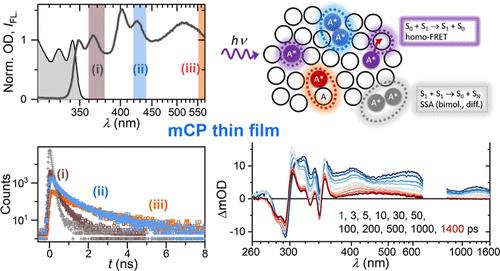当前位置:
X-MOL 学术
›
J. Phys. Chem. C
›
论文详情
Our official English website, www.x-mol.net, welcomes your
feedback! (Note: you will need to create a separate account there.)
Understanding Excited-State Relaxation in 1,3-Bis(N-carbazolyl)benzene, a Host Material for Organic Light-Emitting Diodes
The Journal of Physical Chemistry C ( IF 3.3 ) Pub Date : 2023-02-28 , DOI: 10.1021/acs.jpcc.2c07440 Marius Morgenroth 1 , Thomas Lenzer 1 , Kawon Oum 1
The Journal of Physical Chemistry C ( IF 3.3 ) Pub Date : 2023-02-28 , DOI: 10.1021/acs.jpcc.2c07440 Marius Morgenroth 1 , Thomas Lenzer 1 , Kawon Oum 1
Affiliation

|
We present a detailed spectroscopic study of 1,3-bis(N-carbazolyl)benzene (mCP), a prototypical host material for blue emitters in organic light-emitting diodes, using time-resolved emission and ultrafast transient absorption spectroscopy. Upon photoexcitation, mCP dissolved in tetrahydrofuran and mCP dispersed at low number density in poly(methyl methacrylate) (PMMA) films show a monoexponential emission decay in the range 6–7 ns. Transient absorption experiments detect the formation of the T1 triplet state from S1 with a quantum yield of ca. 20%, a band maximum at 450 nm, and a lifetime on the microsecond time scale. The strong spectral overlap of S1 stimulated emission and S1 excited state absorption suggests that S1–S1 singlet–singlet annihilation (SSA) based on Förster resonance energy transfer (FRET) should be feasible at high mCP concentrations in mCP:PMMA and neat mCP films. At these concentrations, the intensity of the mCP emission is strongly quenched and the spectra show a dramatic change exhibiting monomer, aggregate, and excimer emission bands. The small Stokes shift and thus the good overlap of the absorption and emission spectra of mCP open up the possibility for efficient diffusive S1 singlet hopping in neat mCP films by means of a multi-step homo-FRET mechanism involving S1 and the respective S0 nearest neighbor. Fluence-dependent transient absorption measurements find pronounced S1–S1 SSA. Kinetic modeling suggests a bimolecular diffusive SSA mechanism with a rate constant kdiff of 1.40 × 10–8 cm3 s–1. In contrast, modeling based on direct S1–S1 FRET results in an unrealistically large Förster radius of 17 nm. These experiments therefore suggest that mCP molecules in S1 efficiently diffuse through the mCP film by multi-step homo-FRET and annihilate upon approaching a critical distance to another mCP molecule in S1. Finally, we find clear spectral evidence for vibrationally hot mCP molecules (S0*) in the transient absorption spectra of neat mCP thin films, which cool down on a time scale from nanoseconds to microseconds.
中文翻译:

了解 1,3-双(N-咔唑基)苯的激发态弛豫,有机发光二极管的主体材料
我们使用时间分辨发射和超快瞬态吸收光谱对 1,3-双(N-咔唑基)苯 (mCP) 进行了详细的光谱研究,mCP 是有机发光二极管中蓝色发射体的原型主体材料。光激发后,溶解在四氢呋喃中的 mCP 和以低数密度分散在聚(甲基丙烯酸甲酯)(PMMA)薄膜中的 mCP 显示出 6-7 ns 范围内的单指数发射衰减。瞬态吸收实验检测到 S 1的 T 1三重态的形成,量子产率为 ca。20%,最大波段为 450 nm,寿命为微秒级。S 1受激发射和S 1的强光谱重叠激发态吸收表明,基于 Förster 共振能量转移 (FRET) 的S 1 –S 1单线态-单线态湮灭 (SSA) 在 mCP:PMMA 和纯 mCP 薄膜中的高 mCP 浓度下应该是可行的。在这些浓度下,mCP 发射的强度被强烈淬灭,光谱显示出显着的变化,显示出单体、聚集体和准分子发射带。小的 Stokes 位移和 mCP 的吸收和发射光谱的良好重叠开辟了通过涉及 S 1和相应 S 0最近的邻居。依赖注量的瞬态吸收测量发现明显的 S 1 –S 1 SSA。动力学模型表明一种双分子扩散 SSA 机制,其速率常数k diff为 1.40 × 10 –8 cm 3 s –1。相比之下,基于直接 S 1 –S 1 FRET 的建模会导致 17 nm 的不切实际的大 Förster 半径。因此,这些实验表明,S 1中的 mCP 分子通过多步均质 FRET 有效地扩散通过 mCP 膜,并在接近 S 1中另一个 mCP 分子的临界距离时湮灭. 最后,我们在纯 mCP 薄膜的瞬态吸收光谱中找到了振动热 mCP 分子 (S 0 * ) 的清晰光谱证据,这些薄膜在从纳秒到微秒的时间尺度上冷却下来。
更新日期:2023-02-28
中文翻译:

了解 1,3-双(N-咔唑基)苯的激发态弛豫,有机发光二极管的主体材料
我们使用时间分辨发射和超快瞬态吸收光谱对 1,3-双(N-咔唑基)苯 (mCP) 进行了详细的光谱研究,mCP 是有机发光二极管中蓝色发射体的原型主体材料。光激发后,溶解在四氢呋喃中的 mCP 和以低数密度分散在聚(甲基丙烯酸甲酯)(PMMA)薄膜中的 mCP 显示出 6-7 ns 范围内的单指数发射衰减。瞬态吸收实验检测到 S 1的 T 1三重态的形成,量子产率为 ca。20%,最大波段为 450 nm,寿命为微秒级。S 1受激发射和S 1的强光谱重叠激发态吸收表明,基于 Förster 共振能量转移 (FRET) 的S 1 –S 1单线态-单线态湮灭 (SSA) 在 mCP:PMMA 和纯 mCP 薄膜中的高 mCP 浓度下应该是可行的。在这些浓度下,mCP 发射的强度被强烈淬灭,光谱显示出显着的变化,显示出单体、聚集体和准分子发射带。小的 Stokes 位移和 mCP 的吸收和发射光谱的良好重叠开辟了通过涉及 S 1和相应 S 0最近的邻居。依赖注量的瞬态吸收测量发现明显的 S 1 –S 1 SSA。动力学模型表明一种双分子扩散 SSA 机制,其速率常数k diff为 1.40 × 10 –8 cm 3 s –1。相比之下,基于直接 S 1 –S 1 FRET 的建模会导致 17 nm 的不切实际的大 Förster 半径。因此,这些实验表明,S 1中的 mCP 分子通过多步均质 FRET 有效地扩散通过 mCP 膜,并在接近 S 1中另一个 mCP 分子的临界距离时湮灭. 最后,我们在纯 mCP 薄膜的瞬态吸收光谱中找到了振动热 mCP 分子 (S 0 * ) 的清晰光谱证据,这些薄膜在从纳秒到微秒的时间尺度上冷却下来。


















































 京公网安备 11010802027423号
京公网安备 11010802027423号